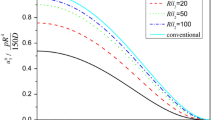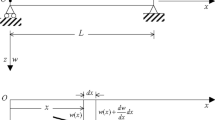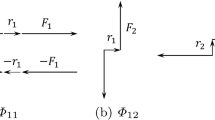Abstract
This paper intends to establish a unified theory of structures based on the micropolar elasticity (ME). ME allows taking into consideration the microstructure of the material, through the adoption of four additional material parameters. In this way, the size-effects of the structure can be caught. The proposed model is developed in the domain of the Carrera unified formulation (CUF), according to which theories of structures can degenerate into unknown kinematics that makes use of an arbitrary expansion of the generalized variables. CUF is a hierarchical formulation that considers the order of the structural model as input of the analysis, so that no specific approximation and manipulation is needed to implement refined theories. Different types of structures have been analyzed in the present work, and the results are compared and validated with benchmarks from the literature. The effects of the new material parameters are addressed too, along with the capability of the proposed model to deal with size-effects and high-order structural behaviors. Finally, stress analysis is detailed to further highlight the differences between micropolar and classical elasticity.














Similar content being viewed by others
References
Euler L (1744) De Curvis Elasticis, Additamentum I to his Methodus Inveniendi Lineas Curvas Maximi Minimive Proprietate Gaudentes. Lausanne and Geneva
Timoshenko SP (1922) On the transverse vibrations of bars of uniform cross-section. Lond Edinb Dublin Philos Mag J Sci 43(253):125–131
Coulomb CA (1784) Recherches théoriques et expérimentales sur la force de torsion et sur l’élasticité des fils de métal. Histoire de l’Académie Royale des Sciences, pp 229–269
de Saint-Venant B (1855) Mémoire sur la torsion des prismes. Mémoires des Savants étrangers 14:233–560
Kennedy TC (1999) Modeling failure in notched plates with micropolar strain softening. Compos Struct 44(1):71–79
Xiaodong L, Bhushan B, Takashima K, Baek C-W, Kim Y-K (2003) Mechanical characterization of micro/nanoscale structures for MEMS/NEMS applications using nanoindentation techniques. Ultramicroscopy 97(1–4):481–494
McFarland AW, Colton JS (2005) Role of material microstructure in plate stiffness with relevance to microcantilever sensors. J Micromech Microeng 15(5):1060
Lam D, Yang F, Chong A, Wang J, Tong P (2003) Experiments and theory in strain gradient elasticity. J Mech Phys Solids 51(8):1477–1508
d Peerlings RHJ, De Borst R, Brekelmans WAM, Geers MGD (2002) Localisation issues in local and nonlocal continuum approaches to fracture. Eur J Mech A/Solids 21(2):175–189
Kunin IA (1982) Elastic media with microstructure I: one-dimensional models, Springer series in solid state sciences, vol 26. Springer, Berlin
Kunin IA (1983) Elastic media with microstructure II: three-dimensional models, Springer series in solid state sciences, vol 44. Springer, Berlin
Maugin GA, Metrikine AV (2010) Mechanics of generalized continua. Springer, Berlin
Voigt W (1887) Theoretische studien über die elasticitätsverhältnisse der krystalle. Königliche Gesellschaft der Wissenschaften zu Göttingen, Göttingen
Cosserat E, Cosserat F (1909) Théorie des corps déformables. A. Hermann et fils, Paris
Eringen AC (1966) Linear theory of micropolar elasticity. J Math Mech 15(6):909–923
Eringen AC (1999) Microcontinuum field theories I: foundations and solids. Springer, Berlin
Eringen AC (2001) Microcontinuum field theories II: fluent media, 2001. Springer, Berlin
Nowacki W (1986) Theory of asymmetric elasticity. Pergamon Press, Oxford
Nowacki W (1972) Theory of micropolar elasticity, vol 25. Springer, Berlin
Yang JFC, Lakes RS (1982) Experimental study of micropolar and couple stress elasticity in compact bone in bending. J Biomech 15(2):91–98
Lakes RS, Nakamura S, Behiri JC, Bonfield W (1990) Fracture mechanics of bone with short cracks. J Biomech 23(10):967–975
Lakes RS (1983) Size effects and micromechanics of a porous solid. J Mater Sci 18(9):2572–2580
Hassanpour S, Heppler GR (2017) Micropolar elasticity theory: a survey of linear isotropic equations, representative notations, and experimental investigations. Math Mech Solids 22(2):224–242
Huang F-Y, Yan B-H, Yan J-L, Yang D-U (2000) Bending analysis of micropolar elastic beam using a 3-D finite element method. Int J Eng Sci 38(3):275–286
Ramezani S, Naghdabadi R, Sohrabpour S (2009) Analysis of micropolar elastic beams. Eur J Mech A/Solids 28(2):202–208
Hassanpour S, Heppler GR (2016) Comprehensive and easy-to-use torsion and bending theories for micropolar beams. Int J Mech Sci 114:71–87
Zozulya VV (2018) Higher order theory of micropolar plates and shells. ZAMM-J Appl Math Mech 98(6):886–918
Zozulya VV (2017) Micropolar curved rods. 2-D, high order, Timoshenko’s and Euler–Bernoulli models. Curved Layer Struct 4(1):104–118
Carrera E, Varello A (2012) Dynamic response of thin-walled structures by variable kinematic one-dimensional models. J Sound Vib 331(24):5268–5282
Fazzolari FA, Carrera E (2013) Accurate free vibration analysis of thermo-mechanically pre/post-buckled anisotropic multilayered plates based on a refined hierarchical trigonometric Ritz formulation. Compos Struct 95:381–402
Pagani A, Carrera E (2018) Unified formulation of geometrically nonlinear refined beam theories. Mech Adv Mater Struct 25(1):15–31
Pagani A, Carrera E (2017) Large-deflection and post-buckling analyses of laminated composite beams by Carrera unified formulation. Compos Struct 170:40–52
Carrera E, Pagani A (2014) Free vibration analysis of civil engineering structures by component-wise models. J Sound Vib 333(19):4597–4620
Carrera E, Petrolo M, Varello A (2011) Advanced beam formulations for free-vibration analysis of conventional and joined wings. J Aerosp Eng 25(2):282–293
Miglioretti F, Carrera E (2015) Application of a refined multi-field beam model for the analysis of complex configurations. Mech Adv Mater Struct 22(1–2):52–66
Carrera E, Zozulya VV (2019) Carrera unified formulation (CUF) for the micropolar beams: analytical solutions. Mech Adv Mater Struct 26(1):1–25
Carrera E, Cinefra M, Petrolo M, Zappino E (2014) Finite element analysis of structures through unified formulation. Wiley, New York
Carrera E, Petrolo M (2012) Refined beam elements with only displacement variables and plate/shell capabilities. Meccanica 47(3):537–556
Carrera E, Cinefra M, Lamberti A, Petrolo M (2015) Results on best theories for metallic and laminated shells including layer-wise models. Compos Struct 126:285–298
Bathe KJ (1996) Finite element procedure. Prentice hall, Upper Saddle River
Carrera E, Cinefra M, Petrolo M, Zappino E (2014) Comparisons between 1D (beam) and 2D (plate/shell) finite elements to analyze thin walled structures. Aerotecnica Missili & Spazio 93(1–2):3–16
Lakes R (1991) Experimental micro mechanics methods for conventional and negative poisson’s ratio cellular solids as Cosserat continua. J Eng Mater Technol 113(1):148–155
Author information
Authors and Affiliations
Corresponding author
Additional information
Publisher's Note
Springer Nature remains neutral with regard to jurisdictional claims in published maps and institutional affiliations.
Appendix: Components of the secant stiffness matrix
Appendix: Components of the secant stiffness matrix
Rights and permissions
About this article
Cite this article
Augello, R., Carrera, E. & Pagani, A. Unified theory of structures based on micropolar elasticity. Meccanica 54, 1785–1800 (2019). https://doi.org/10.1007/s11012-019-01041-z
Received:
Accepted:
Published:
Issue Date:
DOI: https://doi.org/10.1007/s11012-019-01041-z




